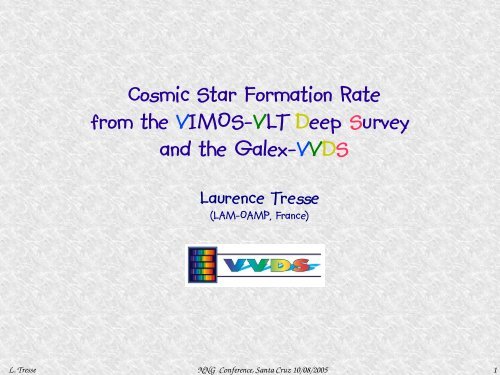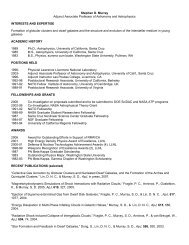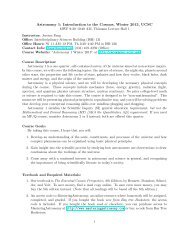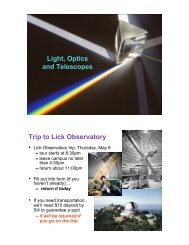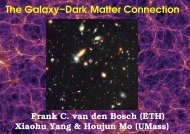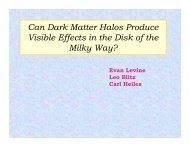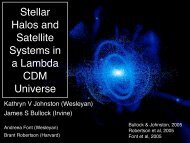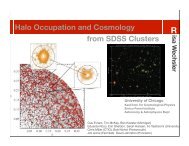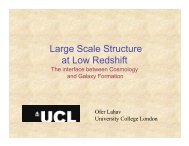Laurence Tresse
Laurence Tresse
Laurence Tresse
You also want an ePaper? Increase the reach of your titles
YUMPU automatically turns print PDFs into web optimized ePapers that Google loves.
Cosmic Star Formation Rate<br />
from the VIMOS-VLT Deep Survey<br />
and the Galex-VVDS<br />
<strong>Laurence</strong> <strong>Tresse</strong><br />
(LAM-OAMP, France)<br />
L. <strong>Tresse</strong> NNG Conference, Santa Cruz 10/08/2005<br />
1
Hα<br />
UV<br />
Redshift Survey<br />
SFR, 1996<br />
Radi<br />
Sub-mm,IR<br />
o<br />
The SFR plot a decade before<br />
Madau et al. '96<br />
The questions were:<br />
Is there a peak at 1.3 < z < 2.7?<br />
By how much interstellar dust attenuates the UV light?<br />
Is it so steep at z
Recap of the VVDS main features<br />
VVDS-CDFS 0.1 deg 2<br />
HST BVIZ<br />
EIS UBVRI<br />
Spectroscopic redshift survey with VIMOS-ESO/VLT<br />
I-band selection VVDS-deep to I AB = 24.0 1.4 deg 2<br />
VVDS-wide to I AB = 22.5 10 deg 2<br />
LRred [5500-9500] Å, R=227, D=7.14 Å/pixel<br />
Exposure ~ 45 mn & 4.5 hours<br />
5 fields<br />
0230-04<br />
CDFS<br />
1000+03<br />
1400+05<br />
2217+00<br />
VVDS-0226-04 1.3 deg 2<br />
Multi-λ<br />
VVDS<br />
U(ESO-WFI) BVRI (CFHT-12K) Jks(ESO-SOFI), VLA 1.4 Ghz<br />
CFTLS Deep ugriz (Y. Mellier)<br />
GALEX NUV, FUV (C.Martin/B.Milliard)<br />
SPITZER-SWIRE NIR, FIR (C. Lonsdale)<br />
XMM (M. Pierre)<br />
4 x 7'x8' ~540 slits<br />
L. <strong>Tresse</strong> NNG Conference, Santa Cruz 10/08/2005<br />
3
The Redshift Distribution<br />
= 0.76 (median =0.9)<br />
Z = 0.0013<br />
First Epoch Data<br />
VVDS-0226-04 1700 arcmin 2 9842 spectra<br />
VVDS-CDFS 500 arcmin 2 1722 spectra<br />
Total = 11564 spectra<br />
Target Sampling rate ~25 %<br />
Q Q% Gal Stars QSO<br />
4 100% 1969 456 11<br />
3 95% 2495 141 27<br />
2 75% 2838 142 21<br />
9 SL 389 0 10<br />
1 50% 1438 64 14<br />
0 no z 744<br />
L. <strong>Tresse</strong> NNG Conference, Santa Cruz 10/08/2005<br />
4
I-selected VVDS & CFRS<br />
1.5 mag fainter, FOV 10 x larger<br />
B-band LFs<br />
Ilbert et al. '05 LF faint end slope<br />
Log(LD)<br />
Δ<br />
1.3<br />
CFRS 2.72±0.5<br />
VVDS 2.05±0.07<br />
Local point higher by ~0.1 in log<br />
At z small change in LD<br />
M* and φ * better constrained at z>0.7<br />
L. <strong>Tresse</strong> NNG Conference, Santa Cruz 10/08/2005<br />
5<br />
SDSS<br />
SAPM<br />
B-band Emissivity<br />
<strong>Tresse</strong> et al. in prep
Ilbert et al. '05<br />
The galaxy population at z < 2<br />
U-band LFs<br />
B-4400<br />
SDSS<br />
U-3600<br />
SDSS<br />
B- and U-band LDs<br />
The total blue emissivity is tightly determined to z~1.3<br />
L. <strong>Tresse</strong> NNG Conference, Santa Cruz 10/08/2005<br />
6<br />
DEEP2<br />
VVDS<br />
VVDS<br />
C17<br />
1.04<br />
1.95<br />
FDF<br />
<strong>Tresse</strong> et al. in prep
Multi-wavelength emissivities<br />
LD<br />
α (1+z) x<br />
G yr<br />
X<br />
K-20000<br />
I-8000 0.21<br />
R-6000 0.49<br />
V-5000 0.69<br />
B-4400 1.04<br />
U-3600 1.95<br />
NUV-2800 1.95<br />
FUV-1500 2.18<br />
<strong>Tresse</strong> et al. in prep<br />
Differential color evolution<br />
At z 0.2L*,<br />
the old, massive long-lived stellar population is<br />
in place at z>1.3<br />
the young, short-lived stellar population is<br />
less & less active<br />
The total (FUV-I) emissivity becomes 4x redder<br />
from z=1.1 to 0<br />
The total mass-related K emissivity is nearly<br />
constant to z=.5 and then increases by a factor 2.5<br />
L. <strong>Tresse</strong> NNG Conference, Santa Cruz 10/08/2005<br />
7
The detailed NNG population at z < 1.5<br />
Best fit Pegase templates on U, B, V, R, I data<br />
Courtesy Ilbert<br />
Lauger et al. AA '05 submitted<br />
I AB = 23<br />
Rest-(B-I) AB<br />
Type 1 CWW-Ell 9% 1.58<br />
Type 2 CWW-Sbc 17% 1.11<br />
Type 3 CWW-Scd 34% 0.79<br />
Type 4 CWW-Irr+SB 40% 0.57<br />
Late types have the strongest EL, and bluest continuum<br />
Early types exhibit star formation D4000, H δ and [OII]<br />
Strong correlation between the bimodality and A-C morphology<br />
Zucca et al. astro-ph/0506393<br />
The spectro-photometric-morphological properties are well correlated at z < 1.5<br />
L. <strong>Tresse</strong> NNG Conference, Santa Cruz 10/08/2005<br />
8
Suite Early<br />
Franzetti et al. in prep<br />
Bimodality clearly present up to z=1.5<br />
Fraction M B < -20<br />
Zucca et al. astro-ph/0506393<br />
Fraction of bright late types decreases by a factor 7<br />
Fraction of bright early types increases by a factor 11<br />
Bright late types dominate at z>1.1<br />
0.6 0.8 1.0 1.2 1.4 1.6<br />
L. <strong>Tresse</strong> NNG Conference, Santa Cruz 10/08/2005<br />
9<br />
redshift<br />
Late<br />
δ gal = b(z,δ,R)δ<br />
Marinoni et al. AA '05<br />
Bright types are not formed below a mass overdensity<br />
whose threshold amplitude decreases with z
Zucca et al. astro-ph/0506393<br />
LFs for Type 1<br />
LFs for Type 4<br />
LF-LD/type<br />
Early-type pop. dominates<br />
L. <strong>Tresse</strong> NNG Conference, Santa Cruz 10/08/2005<br />
10<br />
0.4<br />
0.6<br />
Late-type pop. dominates<br />
<strong>Tresse</strong> et al. in prep
FUV from UBVRI mag<br />
FUV LFs at z < 2<br />
<strong>Tresse</strong> et al. in prep<br />
FUV ABS from NUV-2000 mag<br />
GALEX-VVDS<br />
GALEX-VVDS<br />
HDF HDF<br />
GALEX-VVDS<br />
GALEX-VVDS<br />
Arnouts et al. '05<br />
L. <strong>Tresse</strong> NNG Conference, Santa Cruz 10/08/2005<br />
11
The VVDS high-z population<br />
<strong>Tresse</strong> et al. in prep<br />
Luminosity Functions<br />
HDF<br />
I-selected galaxies<br />
Number Counts<br />
2-6 x more bright gal<br />
Le Fèvre et al. Nature in press<br />
L. <strong>Tresse</strong> NNG Conference, Santa Cruz 10/08/2005<br />
12
Luminosities Densities at 1500Å and at 2800Å<br />
FUV-1500<br />
NUV-2800<br />
2.5±0.7<br />
2.18<br />
1.95<br />
At z < 1 factor 1.4-1.5 between LD-1500 and LD-2800<br />
VVDS, <strong>Tresse</strong> et al. in prep<br />
GALEX-VDDS, Schiminovich et al. '05<br />
Steidel et al. '99 (1700Å)<br />
FDF Gabasch et al. '04<br />
F λ ~ λ β<br />
β GALEX-SDSS, Wyder et al. '05<br />
L. <strong>Tresse</strong> NNG Conference, Santa Cruz 10/08/2005<br />
13<br />
z
The Cosmic SFR History a decade after<br />
4.0±0.2<br />
2.5±0.7<br />
Early type dominated<br />
Late type dominated<br />
--- Hα, <strong>Tresse</strong> et al. '02<br />
--- 12μ m,<br />
Perez-Gonzalez et al. '05<br />
--- 1.4Ghz, Haarsma et al. '00<br />
The Millennium run, Croton et al. '05<br />
Somerville, Primack, Faber '01<br />
Directly observed ionizing UV flux<br />
--- 1500, Schiminovich et al. '05<br />
● 1500, <strong>Tresse</strong> et al. in prep.<br />
□ 1500, Giavalisco et al. '04<br />
■ 1700, Steidel et al. '99<br />
Dust attenuation increases up to z~0.4<br />
then it is constant. It is related to<br />
the change of the dominant population.<br />
L. <strong>Tresse</strong> NNG Conference, Santa Cruz 10/08/2005<br />
14
The VVDS Core Team<br />
PI/Co-PI : Le Fèvre, Vettolani<br />
Builders : Bottini, Garilli, Le Brun, Maccagni, Picat, Scaramella, Scodeggio, <strong>Tresse</strong>, Zanichelli<br />
Core-Members : Adami, Arnouts, Bardelli, Bolzonella, Cappi, Charlot, Ciliegi, Contini,<br />
Foucaud, Franzetti, Gavignaud, Guzzo, Ilbert, Iovino, McCracken, Marano, Marinoni,<br />
Mazure, Meneux, Merighi, Paltani, Pellò, Pollo, Pozzetti, Radovich, Zamorani, Zucca<br />
The Institutes France : Marseille LAM, Toulouse OMP, Paris IAP<br />
Italy : Milan IASF/OABr, Bologne OABo/IRA, Naples OAC<br />
The GALEX team in Marseille and Caltech working with VVDS<br />
Martin (PI), Milliard<br />
Arnouts, Donas, Schiminovich, Treyer<br />
L. <strong>Tresse</strong> NNG Conference, Santa Cruz 10/08/2005<br />
15


